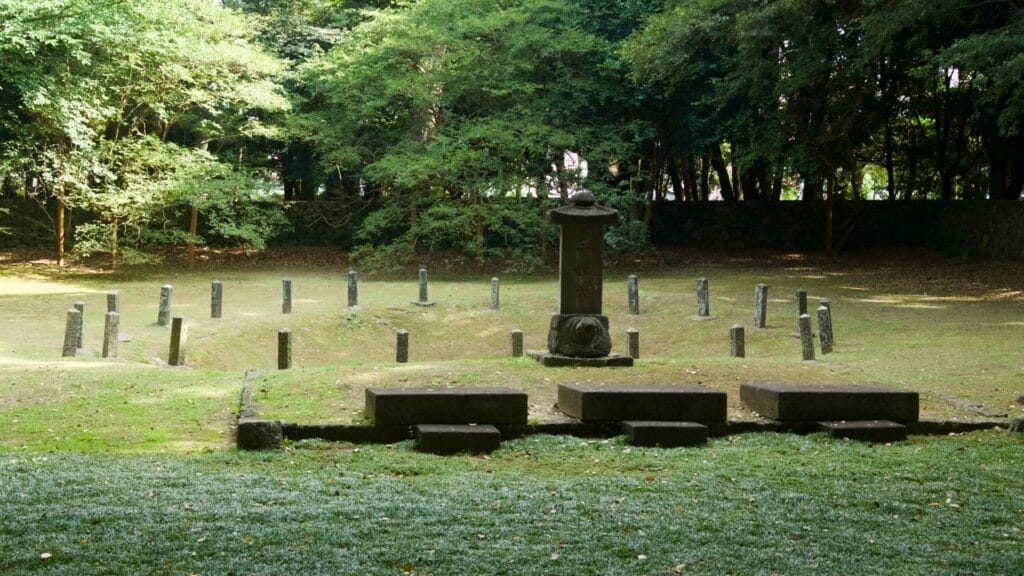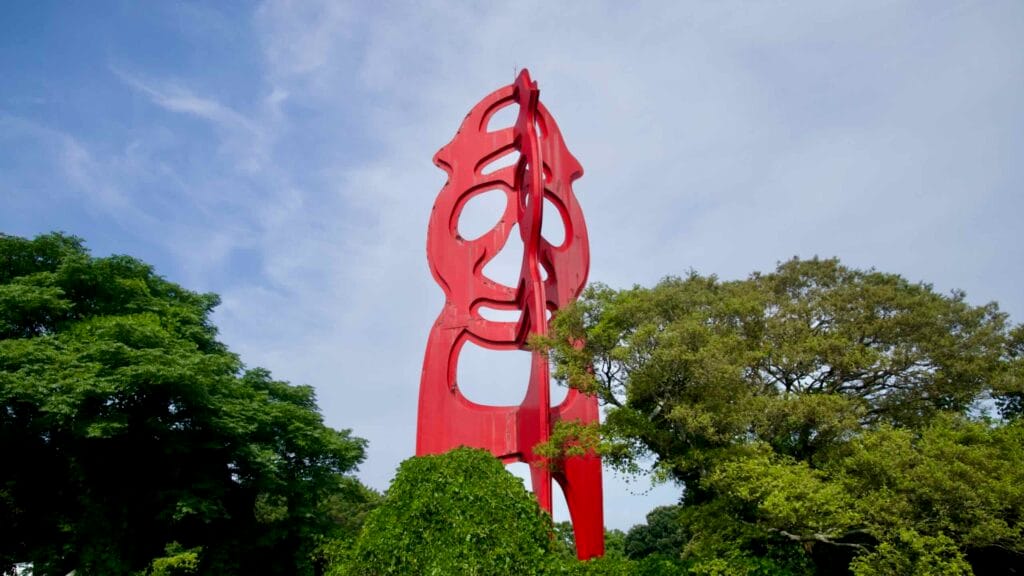Samseonghyeol Archaeological Site
Samseonghyeol Archaeological Site (삼성혈; map) sits in the heart of Jeju City. Known as the “Three Clans’ Holes,” it is where, according to legend, three demigods emerged from the earth to become the founders of Jeju’s ancient kingdom of Tamna.
Designated as Historic Site No. 134 in 1964, the compact and walkable Samseonghyeol is one of the most important archaeological and spiritual sites to Jeju’s residents, holding keys to the island’s founding mythology.
The Legend of the Three Demigods
The Samseonghyeol legend chronicles the emergence of Jeju’s culture and ancient Tamna Kingdom.
Over 4,300 years ago, three demigods—Go Eulna (고을나), Ryang Eulna (양을나), and Bu Eulna (부을나)—are said to have risen from three holes in the ground at the base of Hallasan, the island’s central volcano. Clad in leather garments, initially they lived a simple life, roaming Jeju’s plains, hunting game, and establishing their place on the island.
One day, while gazing toward the eastern sea from Hallasan’s slopes, the demigods noticed a wooden box sealed with purple clay drifting near the shore at Onpyeong Village. Curious, they followed it as it washed ashore and opened it.
Inside, they discovered a jade chest containing five-grain seeds, livestock, and three princesses sent by the Byeokrang, a mythical kingdom from across the sea. The princesses, dressed in elegant blue and purple robes, were accompanied by a messenger who decreed that they were to marry the demigods and help them establish a prosperous civilization.
The marriage between the demigods and the princesses transformed Jeju. The princesses brought with them not only livestock and seeds but also the knowledge of agriculture and animal husbandry. With their guidance, the demigods transitioned from a hunting lifestyle to a settled agricultural society. This shift symbolized the beginnings of organized civilization on Jeju Island and laid the groundwork for the establishment of Tamna, the island’s ancient kingdom.
Foundation of the Three Clans
Each demigod married one princess, and from these unions emerged the three major family clans of Jeju—Go, Ryang, and Bu.
These clans became the pillars of Tamna and remain a part of Jeju’s identity today. The descendants of these clans continue to honor their ancestral ties to the demigods through rituals and traditions, ensuring that the legend remains a living part of Jeju’s heritage.
Symbolism
Samseonghyeol is one of Korea’s oldest cultural landmarks. Unlike typical Korean origin stories, which feature deities descending from the heavens, the Samseonghyeol legend emphasizes a connection to the earth. The demigods’ emergence from the ground mirrors the island’s creation, birthed from the volcanic activity of Mount Hallasan.
Key Features
The Samseonghyeol Archaeological Site includes several key features that highlight its importance. Let’s explore them.
The Three Holes
The centerpiece of Samseonghyeol, the three holes in the ground, symbolize the birthplace of the demigods Go Eulna, Ryang Eulna, and Bu Eulna. Arranged in a “品” (pumja) formation, these holes are surrounded by ancient trees that bow toward them.
Local lore holds that the holes never retain water, regardless of heavy rain or snow.
Samseongjeon Shrine
The Samseongjeon Shrine serves as the spiritual heart of Samseonghyeol. It houses the ancestral tablets of the three demigods and is the focal point for various ceremonial rites.
These include the annual spring and autumn rituals, as well as the winter Gunsi Daeje ceremony. Visitors can view the shrine’s intricately designed interiors, which honor the legacy of the three clans and their contribution to Jeju’s history.
Samseongmun Gate
The Samseongmun Gate marks the entrance to the sacred grounds of Samseonghyeol. Passing through this gate is said to represent entering a space where the physical and mythical worlds intersect.
The gate’s design reflects traditional Korean architecture and sets the tone for visitors . It is also the starting point for guided tours and rituals held within the site.
Exhibition Hall
Samseonghyeol’s on-site Exhibition Hall retells the legend of Samseonghyeol, the foundation of the ancient kingdom of Tamna, and the role of the Go, Ryang, and Bu clans in Jeju’s history.
Visitors can explore artifacts, models, and interactive exhibits, gaining a deeper understanding of the island’s mythology and heritage.
Seasonal Rituals
Samseonghyeol is a living cultural landmark where seasonal rites still honor the three demigods of Tamna. Each year the Spring Ceremony (춘제) on April 10 and the Autumn Ceremony (추제) on October 10 pay homage to Go Eulna, Ryang Eulna, and Bu Eulna, while the Gunsi Daeje (건시대제) on December 10 commemorates Tamna’s founding and the demigods’ role in guiding Jeju from a hunting society to an agrarian kingdom.
The ceremonies unfold in a set order—purification, offerings, and prayers—led by local officials and clan representatives, with descendants of the Go, Ryang, and Bu clans presenting symbolic tributes. Together, they express renewal, gratitude for the harvest, and the enduring bond between Jeju’s people and their ancestral founders.
Visiting Samseonghyeol
- Address: 22 Samseong-ro, Jeju City, Jeju Province
- Hours: 9:00 AM ~ 6:00 PM
- Admission: Adults ₩4,000; Youth ₩2,500; Children ₩1,500
- Facilities: Parking, an accessible walking path, a visitor center, and cultural interpretation services are available.
- Cultural Tours: Guided tours led by cultural interpreters provide deeper insight into the site’s mythology and significance. These tours last approximately 30 minutes and are included with admission.
Nearby
Samseonghyeol lies in the middle of downtown Jeju City. Directly across the street from it, find a trio of notable landmarks.
Sinsan Park
Sinsan Park (신산공원; map) sits across from Samseonghyeol. Jeju City’s largest green space, it holds several key monuments, including a commemorative torch that celebrated the arrival of the 1988 Seoul Olympics at its center.
Walk its meandering paths and you’ll also spot mixed in with public exercise equipment and rec courts, the “Jeju Time Capsules,” where 1,250 objects were interred in October 1995 for the 50th anniversary of Liberation, art sculpture installations, and memorials dedicated to the Korean War and Jeju’s 4·3 Period, when it fought back against government oppression.
Jeju Folklore & Natural History Museum
Just down the street from Samseonghyeol on the western end of Sinsan Park perches the Jeju Folklore & Natural History Museum (제주민속자연사박물관; map) opened in 1984 and displays Jeju’s geology, marine life, and folk life in one place. Travel its halls and learn about lava landscapes, local species, haenyeo culture, and traditional tools.
The interactive Jeju Experience Center with dioramas and short animated films include a 13-meter Bryde’s whale skeleton recovered on a Jeju beach in 2004.
- Hours: 09:00 ~ 18:00 (closed Mondays and holidays)
- Admission: adults ₩2,000; teens ₩1,000
Jeju Province Culture & Arts Center
On the eastern end of Sinsan Park sits the Jeju Province Culture & Arts Center (제주특별자치도문예회관; map), the province’s main public arts complex. It holds concerts, dance, theater, and exhibitions in three spaces: a grand theater, a black-box-style theater, and gallery spaces.
Operated by the Jeju Special Self-Governing Province Culture & Arts Promotion Center, it opened in 1988 and functions as a hub for local troupes and touring productions.
The Grand Theater seats about 892 and supports full orchestral staging with a revolving/movable stage and an orchestra pit. The small theater has 70 fixed seats. The center also rents 1st and 2nd exhibition halls for shows.























































